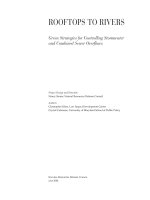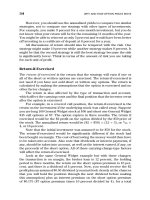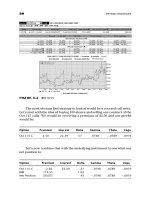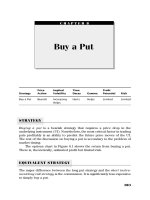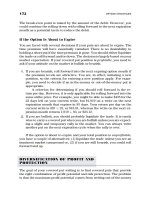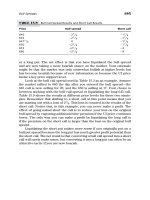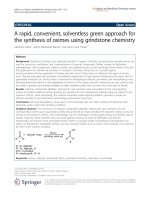Green techniques for organic synthesis and medicinal chemistry, second edition
Bạn đang xem bản rút gọn của tài liệu. Xem và tải ngay bản đầy đủ của tài liệu tại đây (43.24 MB, 709 trang )
www.pdfgrip.com
Green Techniques for Organic Synthesis and
Medicinal Chemistry
www.pdfgrip.com
Green Techniques for Organic Synthesis and
Medicinal Chemistry
Edited by
Wei Zhang
Department of Chemistry
University of Massachusetts–Boston
Massachusetts
USA
Berkeley W. Cue
BWC Pharma Consulting
Nottingham, New Hampshire
USA
Second Edition
www.pdfgrip.com
This edition first published 2018
© 2018 John Wiley & Sons Ltd
All rights reserved. No part of this publication may be reproduced, stored in a retrieval system, or transmitted, in any form or by any means, electronic,
mechanical, photocopying, recording or otherwise, except as permitted by law. Advice on how to obtain permission to reuse material from this title is
available at />The right of Wei Zhang and Berkeley W. Cue to be identified as the authors of the editorial material in this work has been asserted in accordance with law.
Registered Office(s)
John Wiley & Sons, Inc., 111 River Street, Hoboken, NJ 07030, USA
John Wiley & Sons Ltd, The Atrium, Southern Gate, Chichester, West Sussex, PO19 8SQ, UK
Editorial Office
9600 Garsington Road, Oxford, OX4 2DQ, UK
For details of our global editorial offices, customer services, and more information about Wiley products visit us at www.wiley.com.
Wiley also publishes its books in a variety of electronic formats and by print-on-demand. Some content that appears in standard print versions of this book
may not be available in other formats.
Limit of Liability/Disclaimer of Warranty
In view of ongoing research, equipment modifications, changes in governmental regulations, and the constant flow of information relating to the use of
experimental reagents, equipment, and devices, the reader is urged to review and evaluate the information provided in the package insert or instructions
for each chemical, piece of equipment, reagent, or device for, among other things, any changes in the instructions or indication of usage and for added
warnings and precautions. While the publisher and authors have used their best efforts in preparing this work, they make no representations or warranties
with respect to the accuracy or completeness of the contents of this work and specifically disclaim all warranties, including without limitation any implied
warranties of merchantability or fitness for a particular purpose. No warranty may be created or extended by sales representatives, written sales materials
or promotional statements for this work. The fact that an organization, website, or product is referred to in this work as a citation and/or potential source
of further information does not mean that the publisher and authors endorse the information or services the organization, website, or product may provide
or recommendations it may make. This work is sold with the understanding that the publisher is not engaged in rendering professional services. The advice
and strategies contained herein may not be suitable for your situation. You should consult with a specialist where appropriate. Further, readers should be
aware that websites listed in this work may have changed or disappeared between when this work was written and when it is read. Neither the publisher
nor authors shall be liable for any loss of profit or any other commercial damages, including but not limited to special, incidental, consequential, or other
damages.
Library of Congress Cataloging-in-Publication Data
Names: Zhang, Wei, 1961– editor. | Cue, Berkeley W., editor.
Title: Green techniques for organic synthesis and medicinal chemistry / edited by Wei Zhang, Berkeley W. Cue, Jr.
Description: Second edition. | Hoboken, NJ : John Wiley & Sons, 2018. | Includes index. |
Identifiers: LCCN 2017043086 (print) | LCCN 2017047560 (ebook) | ISBN 9781119288176 (pdf ) | ISBN 9781119288589 (epub) |
ISBN 9781119288169 (cloth)
Subjects: LCSH: Pharmaceutical chemistry. | Green chemistry.
Classification: LCC RS403 (ebook) | LCC RS403 .G74 2018 (print) | DDC 615.1/9–dc23
LC record available at />Cover Design: Wiley
Cover Images: (top) © blueclue/Getty Images; (bottom) © funnyangel/Shutterstock
Set in 10/12pt WarnockPro by Aptara Inc., New Delhi, India
10 9 8 7 6 5 4 3 2 1
www.pdfgrip.com
v
Contents
List of Contributors xvii
Foreword xxi
Preface xxiii
Part I
1.1
1.2
1.3
1.3.1
1.3.2
1.3.3
1.3.4
1.3.5
1.4
1.4.1
1.4.2
1.4.3
1.4.4
1.4.5
1.5
1.6
1.7
1.7.1
1.7.2
1.7.3
1.7.4
1.7.5
2.1
2.1.1
General Topics in Green Chemistry
1
Green Chemistry Metrics 3
Frank Roschangar and Juan Colberg
Business Case 3
Historical Context 3
Metrics, Awards, and Barriers 4
Mass-Based Metrics 4
Life-Cycle Assessment 6
Green Analytical Chemistry (GAC) 7
Awards 7
Barriers 9
Metrics Unification Via Green Aspiration Level 9
Standardizing Metrics 10
Defining Analysis Starting Points 10
Considering Drug Manufacturing Complexity 11
Green Aspiration Level (GAL) 11
Relative Process Greenness (RPG) 11
Green Scorecard 12
Supply Chain 14
Outlook and Opportunities 15
Industry-Wide Adaption 15
Integration with LCA 15
Application of GAL to Supply Chain 15
Transformation-Type–Based GAL 15
Opportunities for Government 16
References 17
Green Solvents 21
Janet L. Scott and Helen F. Sneddon
Introduction 21
The Need for Greener Alternatives for Chlorinated Solvents
21
www.pdfgrip.com
vi
Contents
2.1.2
2.1.3
2.2
2.3
2.3.1
2.3.2
2.3.3
2.3.4
2.3.5
2.3.6
2.3.7
2.3.8
2.3.9
2.4
The Need for Greener Alternatives for Dipolar Aprotic Solvents
Scope 23
Solvent Selection Guides and Tools 23
Greener Molecular Solvents 24
Carbonates 24
γ-Valerolactone 25
Dimethylisosorbide 27
Butanol 27
Ethyl Lactate and Lactic Acid 28
Glycerol and Glycerol Derivatives 29
Cyrene 31
2-Methyl Tetrahydrofuran 32
Cyclopentyl Methyl Ether 32
Opportunities, Challenges, and Future Developments 34
References 34
Green Analytical Chemistry 43
Paul Ferguson and Douglas Raynie
Introduction 43
Analytical Method Assessment 44
Case Studies 46
Sample Preparation 47
Sample Preparation Focusing on Liquid Approaches 47
Sample Preparation Using Solid Supports 49
Techniques and Methods 50
Liquid Chromatography 50
Gas Chromatography 57
Supercritical Fluid Chromatography 58
Spectroscopy 60
Process Analytical Technology 60
Biopharmaceutical Analysis 62
Biopharmaceutical Sample Preparation 63
Chromatographic and Electrophoretic Separation 63
PAT for Biopharmaceuticals 65
Conclusions 65
Acknowledgments 66
References 66
3.1
3.1.1
3.1.2
3.2
3.2.1
3.2.2
3.3
3.3.1
3.3.2
3.3.3
3.3.4
3.4
3.5
3.5.1
3.5.2
3.5.3
3.6
4.1
4.2
4.3
4.3.1
4.3.2
4.3.3
4.3.4
4.4
4.4.1
23
Green Engineering 71
Christopher L. Kitchens and Lindsay Soh
Introduction: Green Engineering Misconceptions and Realizations
12 Principles of Green Engineering 72
Green Chemistry Metrics Applied to Engineering 73
Maleic Anhydride Production Example 74
Level 1 Green Chemistry Metrics 74
Level 2 Green Chemistry Metrics 78
Level 3 Green Chemistry Metrics 80
Use of Green Solvents in the Chemical Industry 80
Waste Prevention 80
71
www.pdfgrip.com
Contents
4.4.2
4.4.3
4.4.4
4.4.5
4.4.6
4.4.7
4.5
4.6
Inherently Non-Hazardous 81
Renewable Rather Than Depleting 83
Design for Commercial After-Life 84
Separation and Purification to Minimize Energy Consumption and Materials Use 84
Integration and Interconnectivity with Available Energy and Materials Flows 85
Conserve Complexity 85
Presidential Green Chemistry Awards 86
Opportunities and Outlook 87
References 87
Greening of Consumer Cleaning Products 91
David C. Long
History of Green Consumer Cleaning Products 91
Cleaning Products Before 1990: Great Cleaners but Not Green 91
The Birth of Green Cleaning Products: Green but Didn’t Clean 92
Early Entries in Green Cleaning 93
Green Cleaning Can Provide Better Cleaning: The Historical Influence of Major Manufacturers
Drivers for Greener Products 94
Consumers 94
Governmental Regulations and Non-Governmental Organizations 95
Environmentally Preferable Purchasing Programs 96
Major Retailers 97
Development of Green Cleaning Criteria and Eco-Labeling 98
History and Background 98
Green Seal 100
ECOLOGO 100
EPA’s Design for the Environment/Safer Choice 101
GreenList® 101
Development of Greener Ingredients for Cleaners 102
Background 102
Surfactants 102
Solvents 104
Chelants 105
Oxidizers 107
Colorants and Dyes 108
Fragrances 108
Disinfectants and Preservatives 109
The Future of Green Cleaning 111
Acknowledgments 112
References 112
5.1
5.1.1
5.1.2
5.1.3
5.1.4
5.2
5.2.1
5.2.2
5.2.3
5.2.4
5.3
5.3.1
5.3.2
5.3.3
5.3.4
5.3.5
5.4
5.4.1
5.4.2
5.4.3
5.4.4
5.4.5
5.4.6
5.4.7
5.4.8
5.5
6.1
6.2
6.2.1
6.2.2
6.2.3
6.2.4
Innovation with Non-Covalent Derivatization
John C. Warner and Emily Stoler
Introduction 117
NCD Overview 118
NCD Definitions 118
NCD Design 118
NCD Preparation 119
NCD Characterization 120
117
93
vii
www.pdfgrip.com
viii
Contents
6.3
6.3.1
6.3.2
6.3.3
6.3.4
6.3.5
6.4
Pharmaceutical NCDs 121
API Solubility 121
API Bioavailability 122
API Stability 122
API Additional Performance Enhancements 122
API NCD Future 123
Environmental and Green Chemistry Benefits 123
References 123
Part II
7.1
7.2
7.2.1
7.2.2
7.2.3
7.3
7.3.1
7.4
7.4.1
7.5
7.6
8.1
8.2
8.2.1
8.3
8.4
8.4.1
8.4.2
8.4.3
8.4.4
8.4.5
8.4.6
8.4.7
8.4.8
8.4.9
8.5
9.1
9.2
Green Catalysts
131
Catalytic C-H Bond Cleavage for Heterocyclic Compounds 133
Zhanxiang Liu and Yuhong Zhang
Introduction 133
Synthesis of Nitrogen Heterocycles 133
Synthesis of Five-Membered N-Heterocycles 133
Synthesis of Six-Membered N-Heterocycles 140
Synthesis of Other N-Heterocycles 143
Synthesis of Oxygen-Containing Heterocycles 144
Synthesis of Furan 144
Synthesis of Sulfur-Containing Heterocycles 148
Synthesis of Dibenzothiophenes 148
Medium-Sized Heterocyclic Compounds 150
Conclusion 152
References 152
Biocatalysis 161
James Lalonde
Introduction 161
Enzymes for Biocatalysis 162
Practical Aspects of Using Enzymes in Drug Manufacture 163
Advances in Enzyme Engineering and Directed Evolution 164
Biocatalytic Synthesis of Pharmaceuticals: Case Studies of Highly Efficient Pharmaceutical
Syntheses 165
Atorvastatin 165
Synthesis of Beta-Lactam Antibiotics 168
Pregabalin 169
Sitagliptin, Glasdegib, and Dexamphetamine 170
Simvastatin 172
Sulopenem and Montelukast 173
Boceprevir and Telaprevir 175
Esomeprazole 176
Synthesis of Drug Metabolites 177
Summary and Future Outlook 178
References 180
Practical Asymmetric Organocatalysis 185
Wen-Zhao Zhang, Samik Nanda, and Sanzhong Luo
Introduction 185
Aminocatalysis 185
www.pdfgrip.com
Contents
9.3
9.4
9.5
9.6
9.7
9.8
9.9
Brønsted Acid Catalysis 191
Brønsted Base Catalysis 193
Hydrogen-Bonding Catalysis 197
Phase-Transfer Catalysis 202
Lewis Acid, Lewis Base, and N-Heterocyclic Carbene Catalysis 204
Large-Scale Reaction (>100-Gram Reaction) 207
Conclusion 209
References 209
Fluorous Catalysis 219
L´aszl´o T. Mika and Istv´an T. Horv´ath
Introduction and the Principles of Fluorous Catalysis 219
Ligands for Fluorous Transition Metal Catalysts 224
Synthetic Application of Fluorous Catalysis 225
Hydroformylation 225
Hydrogenation 229
Hydrosylilation 232
Cross-Coupling Reactions 236
Hydroboration 243
Oxidation 243
Esterification, Transesterification, and Acetylation 248
Other Metal Catalyzed Carbon-Carbon Bond–Forming Reactions
Fluorous Organocatalysis 256
Other Applications of Fluorous Catalysis 259
References 259
10.1
10.2
10.3
10.3.1
10.3.2
10.3.3
10.3.4
10.3.5
10.3.6
10.3.7
10.3.8
10.4
10.5
11.1
11.1.1
11.1.2
11.2
11.2.1
11.2.2
11.2.3
11.2.4
11.3
11.3.1
11.3.2
11.3.3
11.3.4
11.3.5
11.4
11.4.1
11.4.2
11.4.3
11.4.4
11.4.5
11.4.6
Solid-Supported Catalysis 269
Sukanta Bhattacharyya and Basudeb Basu
Introduction 269
General Introduction 269
The Impact of Solid-Phase Organic Synthesis on Green Chemistry
Immobilized Palladium Catalysts 270
Suzuki Reactions 270
Mizoroki–Heck Reactions in Water 273
Sonogashira Reactions in Water 274
Tsuji–Trost Reactions in Water 276
Immobilized Rhodium Catalysts 276
Introduction 276
Rhodium(II) Carbenoid Chemistry 277
Rhodium(I)-Catalyzed Addition Reactions 278
Rhodium-Catalyzed Hydrogenation Reactions 278
Rhodium-Catalyzed Carbonylation Reactions 278
Immobilized Ruthenium Catalysts 279
Introduction 279
Ruthenium-Catalyzed Metathesis Reactions 279
Ruthenium-Catalyzed Transfer Hydrogenation 280
Ruthenium-Catalyzed Epoxidation 282
Ruthenium-Catalyzed Cyclopropanation Reactions 282
Ruthenium-Catalyzed Halogenation Reactions 283
250
269
ix
www.pdfgrip.com
x
Contents
11.5
11.5.1
11.5.2
11.5.3
11.6
Other Immobilized Catalysts 284
Immobilized Cobalt Catalysts 284
Immobilized Copper Catalysts 285
Immobilized Iridium Catalysts 285
Conclusions 286
References 287
Asymmetric Organocatalysis in Aqueous Media 291
Kartick C. Bhowmick and Tanmoy Chanda
Introduction 291
Carbon-Carbon Bond-Formation Reactions 292
Aldol Reactions 292
1,4-Conjugate Addition Reactions 305
Mannich Reactions 310
Diels-Alder Reactions 311
Miscellaneous C-C Bond-Forming Reactions 312
Reactions Other than C-C Bond Formation 313
Conclusion 314
References 314
12.1
12.2
12.2.1
12.2.2
12.2.3
12.2.4
12.2.5
12.3
12.4
Part III
13.1
13.2
13.2.1
13.2.2
13.2.3
13.2.4
13.2.5
13.2.6
14.1
14.2
14.3
14.3.1
14.3.2
14.3.3
14.3.4
14.3.5
14.4
14.4.1
14.4.2
14.5
14.6
14.6.1
Green Synthetic Techniques
325
Solvent-Free Synthesis 327
Kendra Leahy Denlinger and James Mack
Introduction 327
Ball Milling 328
Types of Ball Mills 329
Kinetics and Thermodynamics of Solvent-Free Reactions
Hard-Soft Acid-Base Theory 333
Stereoselectivity 334
Catalysis 334
Isolation Techniques 336
References 339
Ultrasonic Reactions 343
Rodrigo Cella and H´elio A. Stefani
Introduction 343
How Does Cavitation Work? 343
Aldol/Condensation Reactions 345
Aldol Reaction 345
Mukaiyama Aldol Reaction 345
Knoevenagel Reaction 346
Claisen-Schmidt Reaction 349
Mannich Reaction 350
1,4-Addition 351
Michael Additions 351
Baylis-Hillman Reaction 353
Heterocycles Synthesis 353
Coupling Reactions 356
Heck Cross-Coupling Reaction 356
330
www.pdfgrip.com
Contents
14.6.2
14.6.3
14.6.4
14.7
14.8
14.9
14.10
Sonogashira Reaction 357
Stille Cross-Coupling 357
Suzuki Cross-Coupling 359
Wittig Reaction 361
Diels-Alder Reaction 362
Miscellaneous 365
Conclusions 366
References 366
Photochemical Synthesis 373
Stefano Protti, Maurizio Fagnoni, and Angelo Albini
Introduction 373
Synthesis and Rearrangement of Open-Chain Compounds 376
Reactions of Olefins 376
Ar-H Functionalization 380
Miscellaneous 380
Synthesis of Three- and Four-Membered Rings 382
Synthesis of Three-Membered Rings 383
Synthesis of Four-Membered Rings 385
Synthesis of Five-, Six- (and Larger)-Membered Rings 391
Synthesis of Five-Membered Rings 391
Synthesis of Six-Membered Rings 394
Synthesis of Larger Rings 397
Oxygenation and Oxidation 398
Conclusions 400
Acknowledgments 401
References 401
15.1
15.2
15.2.1
15.2.2
15.2.3
15.3
15.3.1
15.3.2
15.4
15.4.1
15.4.2
15.4.3
15.5
15.6
16.1
16.2
16.2.1
16.2.2
16.2.3
16.2.4
16.2.5
16.2.6
16.2.7
16.3
16.3.1
16.3.2
16.3.3
16.4
16.4.1
16.4.2
16.4.3
16.5
Pot Economy Synthesis 407
Wenbin Yi, Xin Zeng, and Song Gao
Introduction 407
Multicomponent Reactions 407
The Grieco Reaction 408
The Petasis Reaction 409
The Sonogashira-Type Reaction 410
The Ugi/Knevengagel/Click Reaction 411
MCR involving Aza-Diels-Alder Reaction 412
MCR Involving Fluorination and Trifluoromethylation
Other Kinds of Reactions 413
One-Pot and Multi-Step Reactions 415
Two-Step Reaction Sequences 416
Three-Step Reaction Sequences 418
More Than Three-Step Reaction Sequences 421
One-Pot Asymmetric Synthesis 424
Transition-Metal Catalysis 424
Organocatalysis 427
Chiral Pool-Based One-Pot Synthesis 431
Outlook 434
References 434
412
xi
www.pdfgrip.com
xii
Contents
17.1
17.1.1
17.1.2
17.2
17.2.1
17.2.2
17.2.3
17.3
17.3.1
17.3.2
17.3.3
17.4
17.4.1
17.4.2
17.5
17.6
17.6.1
17.6.2
17.7
18.1
18.2
18.2.1
18.3
18.3.1
18.3.2
18.3.3
18.4
18.5
18.6
18.7
18.8
18.8.1
18.8.2
19.1
19.2
19.3
19.3.1
19.3.2
Microwave-Assisted Organic Synthesis: Overview of Recent Applications
Nandini Sharma, Upendra K. Sharma, and Erik V. Van der Eycken
Introduction 441
Microwave-Assisted MCR Synthesis of N-Containing Heterocycles 442
Coupling Reactions 445
C-H Functionalization 449
Metal-Catalyzed C-H Functionalization 449
Metal-free C-H Functionalization 451
Oxidative C-H Functionalization 451
Insertion Reactions 452
Carbon Dioxide Insertion 452
Carbon Monoxide Insertion 453
Isonitrile Insertion 453
Reduction 453
Microwave-Assisted Hydrogenation of Alkynes and Alkenes 454
Reduction of Carbonyl Groups 454
Synthesis of Peptides and Related Fine Chemicals 455
Newer Developments 459
SiC Reactors and Continuous Flow Synthesis 459
Nanomaterial Synthesis 460
Summary 461
References 461
Solid-Supported Synthesis 469
Indrajeet J. Barve and Chung-Ming Sun
Abbreviations 469
Introduction 471
Techniques of Solid-Phase Supported Synthesis 472
Recent Advances in Linkers for Solid-Supported Synthesis 472
Solid-Phase Supported Heterocyclic Chemistry 476
Solid-Phase Synthesis of Nitrogen Heterocycles 476
Solid-Phase Synthesis of Oxygen Heterocycles 484
Solid-Phase Synthesis of Heterocycles with More Heteroatom 485
Solid-Supported Synthesis of Natural Products 486
Solid-Supported Organometallic Chemistry 491
Solid-Phase Synthesis of Peptides 493
Solid-Phase Supported Stereoselective Synthesis 494
Interdisciplinary Solid-Supported Synthesis 499
Microwave-Assisted Solid-Phase Synthesis 499
Solid-Phase Supported Reagents in Organic Synthesis 502
References 505
Light Fluorous Synthesis 509
Wei Zhang
Introduction 509
“Heavy” Versus “Light” Fluorous Chemistry 509
The Green Chemistry Aspects of Fluorous Synthesis 510
Fluorous Solid-Phase Extraction (F-SPE) to Reduce Waste 510
Recycling Techniques 510
441
www.pdfgrip.com
Contents
19.3.3
19.3.4
19.3.5
19.3.6
19.3.7
19.4
19.4.1
19.4.2
19.4.3
19.4.4
19.4.5
19.4.6
19.5
Monitoring Reactions 510
Fluorous Linker-Facilitated Synthesis 511
Microwave-Assisted Synthesis 511
Multicomponent Reactions 511
Reactions and Separations in Aqueous Media 511
Fluorous Techniques for Discovery Chemistry 511
Fluorous Ligands for Metal Catalysis 511
Fluorous Organocatalysis 514
Fluorous Reagents 516
Fluorous Scavengers 518
Fluorous Linkers 520
Fluorous Mixture Synthesis (FMS) 528
Conclusions 533
References 533
Part IV
20.1
20.2
20.2.1
20.2.2
20.2.3
20.2.4
20.2.5
20.2.6
20.2.7
20.2.8
20.3
21.1
21.2
21.3
21.3.1
21.3.2
21.3.3
21.4
21.4.1
21.4.2
21.4.3
21.5
21.6
Green Techniques and Strategies in the Pharmaceutical Industry
539
Ionic Liquids in Pharmaceutical Industry 541
Julia L. Shamshina, Paula Berton, Hui Wang, Xiaosi Zhou, Gabriela Gurau, and Robin D. Rogers
Abbreviations 541
Introduction 543
Finding the Right Role for ILs in the Pharmaceutical Industry 544
Use of ILs as Solvents in the Synthesis of Drugs or Drug Intermediates 544
Use of ILs for Pharmaceutical Crystallization 546
Use of ILs in Pharmaceutical Separations 547
Use of ILs for the Extraction of Drugs From Natural Products 551
Use of ILs for Drug Delivery 552
Use of ILs for Drug Detection 553
ILs as Pharmaceutical Ingredients 554
ILs in Membrane Transport 566
Conclusions and Prospects 567
References 568
Green Technologies and Approaches in the Manufacture of Biologics 579
Sa V. Ho and Kristi L. Budzinski
Introduction 579
Characteristics of Biologics 580
Manufacture of Therapeutic Biologics 581
General Characteristics of Conventional Biologics Manufacturing 581
Process and Analytical Technologies 583
Manufacturing Facilities 586
Environmental Metrics Development and Impact Analysis 587
Mass-Based Metrics 587
Energy-Based Metrics 589
Life-Cycle Assessment 591
Some Future Directions 592
Conclusions 594
Acknowledgments 594
References 594
xiii
www.pdfgrip.com
xiv
Contents
22.1
22.2
22.3
22.3.1
22.3.2
22.3.3
22.3.4
22.3.5
22.3.6
22.3.7
22.4
22.4.1
22.4.2
22.4.3
22.5
22.6
23.1
23.2
23.3
23.4
23.5
23.5.1
23.6
23.7
23.8
23.9
23.10
23.11
24.1
24.2
24.2.1
24.2.2
24.2.3
24.3
Benchmarking Green Chemistry Adoption by “Big Pharma” and Generics Manufacturers
Vesela R. Veleva and Berkeley W. Cue
Introduction 601
Literature Review 602
Pharmaceutical Industry Overview and Green Chemistry Drivers 604
Cost Savings 605
Improved Reputation 605
Environmental Impacts of Pharmaceuticals 605
Legislation 606
Customer Demands 606
Investor Pressures 607
Attracting and Retaining Talent 607
Benchmarking Industry Adoption of Green Chemistry 607
Methods 607
Innovative Pharmaceutical Companies 608
Generic Pharmaceutical Companies 608
Results and Discussion 610
Conclusion 616
References 616
601
Green Process Chemistry in the Pharmaceutical Industry: Case Studies Update (–) 621
Joseph M. Fortunak, Ji Zhang, Frederick E. Nytko III, and Tiffany N. Ellison
Introduction 621
Pharmaceutical Patents Driving Innovation 622
A Caution About Drug Manufacturing Costs 623
Process Evolution by Multiple Route Discovery Efforts—Dolutegravir 624
The Impact of Competition on Process Evolution—Tenofovir Disoproxil Fumarate 628
Tenofovir Disoproxil Fumarate: The Cumulative Impact of Incremental Process Improvements 632
Simeprevir (Olysio/Sovriad) and Analogues: Chiral Phase-Transfer Catalyst-Promoted Optical
Alpha-Amino Acid Synthesis: A Metal-free Process 633
Vaniprevir (MK 7009), Simeprevir (TMC435), and Danoprevir: Ring-Closing Metathesis (RCM)
for Macrocyclic Lactam Synthesis: Now a Commercial Reality 635
Daclatasvir (BMS-790052, Daklinza), and Ledipasvir (GS-5885): Palladium Catalyzed
Cross-Coupling for Greening a Process 638
Sitagliptin (Januvia) and Ponatinib (Iclusig): Greening the Process by Telescoping Multiple Steps
Together 639
Febuxostat (Uloric): Greening the Process via Metal Catalyzed C-H Activation: A Prospect 641
Conclusions 644
References 644
Greener Pharmaceutical Science Through Collaboration: The ACS GCI
Pharmaceutical Roundtable 649
Julie B. Manley and Michael E. Kopach
Introduction 649
Establishing Pre-Competitive Collaborations 650
Background 650
Mission and Membership 651
Strategic Priorities 652
Informing and Influencing the Research Agenda 654
www.pdfgrip.com
Contents
24.3.1
24.3.2
24.4
24.4.1
24.4.2
24.4.3
24.4.4
24.4.5
24.5
24.5.1
24.5.2
24.5.3
24.6
24.6.1
24.6.2
24.7
24.7.1
24.7.2
24.7.3
24.7.4
24.8
24.8.1
24.8.2
24.8.3
24.8.4
24.8.5
24.8.6
Key Research Areas 654
Research Grants 656
Developing Tools 661
Process Mass Intensity 661
Solvent Guide 662
Reagent Guide 662
Electronic Lab Notebooks 663
Continuous Processing Business Cases
Educating Leaders 666
Articles of Interest 667
Influencing Editorial Policy 667
Future Scientists 667
Collaborating Globally 668
Internal Collaboration 668
External Collaboration 668
Future Opportunities 669
Analytical Chemistry 669
Animal Health Products 669
Generic Manufacturing 670
Drug Delivery Formulation 670
Success Factors 671
Unique Value Proposition 671
Degree of Commonality 671
Critical Mass 671
Financial Investment 672
In-Kind Contribution 672
Leadership 672
References 673
Index 675
664
xv
www.pdfgrip.com
xvii
List of Contributors
Angelo Albini
PhotoGreen Lab Department of Chemistry,
University of Pavia, Italy
Juan Colberg
Pfizer Global Research and Development, Pfizer Inc.,
Groton, Connecticut, USA
Indrajeet J. Barve
Department of Applied Chemistry, National Chiao
Tung University, Hsinchu, Taiwan
Berkeley W. Cue
BWC Pharma Consulting, LLC, Nottingham, New
Hampshire, USA
Basudeb Basu
Department of Chemistry, North Bengal University,
Darjeeling, India
Tiffany N. Ellison
Department of Chemistry, Howard University,
Washington, District of Columbia, USA
Paula Berton
Department of Chemistry, McGill University,
Montreal, Quebec, Canada
Sukanta Bhattacharyya
Supra Sciences, Inc., Belmont, California, USA
Kartick C. Bhowmick
Division of Organic Synthesis, Department of
Chemistry, Visva-Bharati (A Central University),
Santiniketan, West Bengal, India
Kristi L. Budzinski
Environment, Health and Safety, Genentech,
a member of the Roche Group, San Francisco,
California, USA
Rodrigo Cella
FEI-Chemical Engineering Department, S˜ao
Bernardo do Campo, Brazil
Tanmoy Chanda
Department of Chemistry, University of Texas at
San Antonio, USA
Maurizio Fagnoni
PhotoGreen Lab Department of Chemistry,
University of Pavia, Italy
Paul Ferguson
Global Product Development, AstraZeneca,
Macclesfield, UK
Joseph M. Fortunak
Department of Chemistry, Howard University,
Washington, District of Columbia, USA
Song Gao
Chemical Engineering College, Nanjing University of
Science and Technology, Nanjing, China
Gabriela Gurau
525 Solutions. Inc., Tuscaloosa, Alabama, USA
Sa V. Ho
Pfizer Biotherapeutics Pharmaceutical Sciences
(retired), Rochester, Minnesota, USA
www.pdfgrip.com
xviii
List of Contributors
Istv´an T. Horv´ath
Department of Biology and Chemistry,
City University of Hong Kong, Kowloon,
Hong Kong SAR
Christopher L. Kitchens
Clemson University, Clemson, South Carolina, USA
Michael E. Kopach
Eli Lilly and Company, Indianapolis, Indiana, USA
James Lalonde
Codexis, Inc., Redwood City, California, USA
Frederick E. Nytko III
Department of Chemistry, Howard University,
Washington, District of Columbia, USA
Stefano Protti
PhotoGreen Lab Department of Chemistry,
University of Pavia, Italy
Douglas Raynie
Department of Chemistry & Biochemistry, South
Dakota State University, Avera Health and Science
Centre, Brookings, South Dakota, USA
Kendra Leahy Denlinger
Department of Chemistry, University of Cincinnati,
Cincinnati, Ohio, USA
Robin D. Rogers
Department of Chemistry, McGill University,
Montreal, Quebec, Canada and 525 Solutions, Inc.,
Tuscaloosa, Alabama, USA
David C. Long
Environmental Sustainability Solution, LLC
Consulting, Frankfort, Michigan, USA
Frank Roschangar
Boehringer Ingelheim Pharmaceuticals, Inc.,
Ridgefield, Connecticut, USA
Zhanxiang Liu
Department of Chemistry, Zhejiang University,
Hangzhou, China
Janet L. Scott
Centre for Sustainable Chemical Technologies and
Department of Chemistry, University of Bath, Bath,
UK
Sanzhong Luo
Beijing National Laboratory for Molecular Sciences,
Institute of Chemistry, Chinese Academy of
Sciences, Beijing, China
James Mack
Department of Chemistry, University of Cincinnati,
Cincinnati, Ohio, USA
Julie B. Manley
Guiding Green, LLC, Sanford, Michigan, USA
Julia L. Shamshina
525 Solutions, Inc., Tuscaloosa, Alabama, USA
Nandini Sharma
Laboratory for Organic & Microwave-Assisted
Chemistry (LOMAC), Department of Chemistry,
University of Leuven, Belgium
Upendra K. Sharma
Laboratory for Organic & Microwave-Assisted
Chemistry (LOMAC), Department of Chemistry,
University of Leuven, Belgium
L´aszl´o T. Mika
Department of Chemical and Environmental Process
Engineering, Budapest University of Technology and
Economics, Budapest, Hungary
Helen F. Sneddon
GSK Medicines Research Centre, Gunnels Wood
Road, Stevenage, Herts, SG1 2NY, UK
Samik Nanda
Beijing National Laboratory for Molecular Sciences,
Institute of Chemistry, Chinese Academy of
Sciences, Beijing, China
Lindsay Soh
Chemical and Biomolecular Engineering
Department, Lafayette College, Easton,
Pennsylvania, USA
www.pdfgrip.com
List of Contributors
Helio A. Stefani
University of S˜ao Paulo, Faculty of Pharmaceutical
Science, S˜ao Paulo, Brazil
Wenbin Yi
Chemical Engineering College, Nanjing University of
Science and Technology, Nanjing, China
Emily Stoler
The Warner Babcock Institute for Green Chemistry,
LLC Wilmington, Massachusetts, USA
Xin Zeng
Chemical Engineering College, Nanjing University of
Science and Technology, Nanjing, China
Chung-Ming Sun
Department of Medicinal and Applied Chemistry,
Kaohsiung Medical University, Kaohsiung, Taiwan
Ji Zhang
HEC Pharm Co., Ltd., Dongguan, Guangdong, China
Erik V. Van der Eycken
Laboratory for Organic & Microwave-Assisted
Chemistry (LOMAC), Department of Chemistry,
University of Leuven, Belgium
Vesela R. Veleva
Department of Management, University of
Massachusetts-Boston, USA
Hui Wang
Institute of Process Engineering, Chinese Academy
of Sciences, Beijing, China
John C. Warner
The Warner Babcock Institute for Green Chemistry,
LLC Wilmington, Massachusetts, USA
Wei Zhang
Center for Green Chemistry, Department of
Chemistry, University of Massachusetts–Boston
Wen-Zhao Zhang
Beijing National Laboratory for Molecular Sciences,
Institute of Chemistry, Chinese Academy of
Sciences, Beijing, China
Yuhong Zhang
Department of Chemistry, Zhejiang University,
Hangzhou, China
Xiaosi Zhou
Jiangsu Key Laboratory of Biofunctional Materials,
School of Chemistry and Material Science, Nanjing
Normal University, Nanjing, China
xix
www.pdfgrip.com
xxi
Foreword
This second edition of Green Techniques for Organic Synthesis and Medicinal Chemistry by Cue and Zhang is
a collection of the cutting-edge research and intellectual perspectives from the leaders in the field of chemistry in both industry and academia. It reflects the exponential growth that is taking place in the chemical
enterprise around the world and the ways that elegance in chemistry is being defined. Within the context of
their time, the giants of synthetic chemistry of the past would undertake and accomplish herculean feats of
molecular manipulation that were previously thought impossible. While those feats need to be recognized for
the historical advances that they were, it is equally true that we have evolved to see their limitations in the
current day. Many of the techniques that were developed were harsh, or toxic, or posed physical hazards, or
caused inordinate waste generation. In other words, they caused a number of new problems while they were
solving the problem that they were focused upon. Two steps forward and one (or more) steps back.
This book more than anything else shows the elevation in thinking that has allowed the field to recognize
that a systems perspective is essential to avoid unintended consequences. More importantly, a systems perspective is one of the most powerful drivers to genuine impactful innovation. Each of the topics covered in this
book demonstrates not merely an advance in the discovery, demonstration, and development of a molecule
or synthetic pathways, but also an advance in the design thinking behind the chemistry.
The topics in the book are as varied and diverse as the field of green chemistry itself, which is a tribute to the
vision of the editors. When the area of catalysis is addressed it covers new thinking in terms aqueous catalysis
in Chapter 12, “Asymmetric Catalysis in Aqueous Media” by Kartik C. Bhowmick and Tanmoy Chanda that
combines the perspective on catalyst development with the insights of how the properties of water can be
used to facilitate stereo-selectivity. The founder of fluorous solvents, Istv´an T. Horv´ath (along with co-author
L´aszl´o T. Mika), brings his decades long perspectives on catalysis to bear Chapter 10, “Fluorous Catalysis.”
The advantages of biocatalysis to the goals of industrial green chemistry are addressed in Chapter 8 by James
Lalonde from Codexis and Chapter 9 by Luo and Zhang portray the leading edge of asymmetric and C-H bond
catalysis respectively.
Just as the chapters on catalysis look at the broader systems that enable and empower green catalysts, the
section on synthetic techniques takes a similar approach. Alternative approaches to chemical media and synthetic processes is exemplified through the chapters on solvent-free synthesis, microwave synthesis, ultrasonic
synthesis by Mack, Van der Eycken, and Stefani, respectively and demonstrate the need for demonstration and
scale up of these innovative approaches to synthesis. Chapters from Yi, Rogers, Shamshina, Kitchens, Soh, and
Sun highlight the combining of the thinking of traditional methodologies with solvent systems and engineered
systems in the chapters. Too often synthetic methodologies have been tossed over the proverbial transom to
the process engineers, which has brought about frustration, delays, cost, and sub-optimal results. These chapters are indicative of the thinking in green chemistry and green engineering that is taking place to displace
those old inefficiencies.
The chapters that focus on real-world examples from the pharmaceutical sector provides current perspectives on the critical topics ranging across processes, metrics, regulations, and industrial collaborations in green
chemistry. This section has particular value for those wishing to know what the essential elements are for any
individual or company wishing to engage or advance green chemistry within the pharmaceutical sector.
www.pdfgrip.com
xxii
Foreword
Of all of the innovative parts of the book, perhaps the most intellectually challenging is Part I, which combines thinkers from across the spectrum of industry, academia, and not-for-profit institutions to discuss the
grand state of affairs in green chemistry, including a chapter by Stohl and Warner who illustrate green chemistry innovation with examples of their research into non-covalent derivatives. The remaining chapters survey
the field from regulations to formulations to analysis and provide a definitive overview for the reader.
This book gives the readers a glimpse at the horizons that can be accomplished through green chemistry
thinking and innovation. By moving from a focus on efficiency, to effectiveness, toward the ideal, the field of
green chemistry has evolved over 25 years and that evolution is reflected in the chapters. The editors of this
volume, Cue and Zhang, have combined the broadest perspectives of green chemistry with the most insightful
scientists in the field and produced a volume that represents the frontier of the green chemistry enterprise
in 2017.
Paul T. Anastas
New Haven, Connecticut, USA
www.pdfgrip.com
xxiii
Preface
We are pleased to present the second edition of Green Techniques for Organic Synthesis and Medicinal Chemistry. According to a Web of Science search by the end of 2016, more than 40% of all the papers in the field
of green chemistry have appeared since our first edition was published in 2012, documenting the continuing
explosive growth of green chemistry. In this new edition we have presented topics in chapters that reflect
the breadth and depth of this growing field of chemistry. This 24-chapter book has 55 contributing authors,
including 20 who contributed chapters to the first edition and 35 who are new contributors to this edition,
and who represent academia and industry from around the world. Of the 24 chapters, 9 introduce subjects
that are new to this edition and all of them contain a major focus on the science that has emerged in recent
years. We sincerely thank all our authors for their excellent and dedicated work to complete this project. We
acknowledge Ms. Sarah Higginbotham from Wiley for inviting us to contribute this new edition and for her
help with the preparation and review of our book proposal. We thank Ms. Elsie Merlin, Ms. Rebecca Ralf,
Ms. Emma Strickland, Tricia Lawrence, and Shalini Sharma at different stages of this project including communicating with authors, typesetting, proofreading and cover design, and Dr. Paul Anastas for contributing
the foreword. Each of them helped to make this book better than it would otherwise have been. Finally, and
most importantly, we thank our family members. A project like this always seems to demand more time and
a higher priority than we realize and often this time is taken from them. For their patience and understanding
we are grateful.
Wei Zhang is a faculty member and Berkeley W. Cue is a 1969 alumnus and adjunct professor in the Chemistry Department of the University of Massachusetts-Boston (UMB). UMB has a strong tradition in green
chemistry and many outstanding alumni including Dr. Paul Anastas, Dr. Nicholas Anastas, Dr. Amy Cannon,
and Dr. John Warner. UMB established the first PhD program in green chemistry and the Center for Green
Chemistry. So far over 20 students have been awarded their PhD degrees in this field. In 2015, UMB hosted
the third Global Green Chemistry Centers (G2 C2 ) conference in its newly opened Integrated Science Center
(ISC). In 2016, the Green Chemistry Centers of Yale University and UMB held a joint symposium celebrating UMB alumni’s green chemistry achievements. We sincerely thank the UMB Chemistry department, the
College of Science and Mathematics, and the university for providing continuous support to green chemistryrelated activities, including the publication of this book.
Wei Zhang
Boston, Massachusetts, USA
Berkeley W. Cue
Nottingham, New Hampshire, USA
April 2017
www.pdfgrip.com
Part I
General Topics in Green Chemistry
www.pdfgrip.com
www.pdfgrip.com
Green Chemistry Metrics
Frank Roschangar1 and Juan Colberg2
1
2
Boehringer Ingelheim Pharmaceuticals, Inc., Ridgefield, Connecticut, USA
Pfizer Global Research and Development, Pfizer Inc., Groton, Connecticut, USA
. Business Case
Green chemistry is an integral, strategic component for pharmaceutical firms to inspire development of drug
manufacturing processes with optimal environmental impact, process safety, and energy consumption, all
of which bring about improved economics. Manufacturing contributes a substantial part of industry expenditures that has been estimated at one-third of total costs to one-third of total sales, or about $200 billion
worldwide in 2008 [1, 2]. This figure includes about 10 billion kg of annual drug manufacturing waste treatment with costs of $20 billion [3]. Therefore, if effectively utilized, green chemistry represents a significant
opportunity for industry to increase drug development and manufacturing efficiencies that could translate to
trillions of dollars in social value for the public health consumer surplus [4]. This is precisely the reason why
industry should optimally utilize green chemistry. In this context, metrics become vital as a reflection of corporate priority, in line with the proven management adage “you can’t manage what you don’t measure.” Unless
improvements are defined, quantified, and measured, we cannot establish clear objectives that allow us to
estimate manufacturing improvements. We must, therefore, measure green chemistry by carefully choosing
metrics that matter. Ideally, those selected metrics are standardized and aligned within the industry, and also
leveraged within the firms with key stakeholders, namely company leadership, technical staff, and suppliers,
thereby promoting a culture of continuous ambition and improvement. It was not until 23 years after introduction of the E factor [5] that the first standardized and unified green manufacturing goal metric became
available that will be detailed vide infra [6, 7].
. Historical Context
The origins of metrics date back to 1956 when Nobel laureate Woodward questioned how to create the best
possible synthesis, and invented the concept of synthetic design [8]: “synthesis must always be carried out
by a plan, and the synthetic frontier can be defined only in terms of the degree to which realistic planning
is possible, utilizing all of the intellectual and physical tools available.” In 1989, Corey leap-frogged the field
of synthetic design by introduction of retrosynthesis methodology, in which the chemist starts planning
from the product backward via the most efficient bond dissection to arrive at simple and readily available
raw materials [9]. For these contributions, he was awarded the 1990 Nobel Prize in Chemistry. The initial
considerations for environment in synthetic planning, and thus the first environmental green chemistry
metrics, can be traced to Trost and Sheldon who went beyond synthesis design and assessed efficiency
through Atom Economy (AE) [10] and Environmental impact factor (E factor) [11] in 1991 and 1992,
Green Techniques for Organic Synthesis and Medicinal Chemistry, Second Edition. Edited by Wei Zhang and Berkeley W. Cue.
© 2018 John Wiley & Sons Ltd. Published 2018 by John Wiley & Sons Ltd.
www.pdfgrip.com
Green Techniques for Organic Synthesis and Medicinal Chemistry
Table . E factors, waste and process complexity across chemical industries.
Industry Segment
(Examples)
Annual Product
Tonnage
E-Factor (kg waste/
kg product)
Total Annual
Waste Tonnage
No. of Steps
Years of
Development
Petrochemicals
(Solvents, Detergents)
1,000,000–
100,000,000
∼0.1
10,000,000
“Separations”
100+
Bulk Chemicals
(Plastics, Polymers)
10,000–
1,000,000
<1–5
5,000,000
1–2
10–50
Fine Chemicals
(Coatings, Electronic
Parts, Pharmaceutical
Raw Materials)
100–10,000
5–>50
500,000
3–4
4–7
Pharmaceuticals
(Antibiotics, Drugs,
Vaccines)
10–1,000
25–>100
100,000
6+
3–5
respectively, with the implied goal to consider waste as a criterion for molecular design and thereby minimize
it. AE measures what proportion of the reactants becomes part of the product, and as such addresses a
shortcoming of chemical yield (CY). For example, we can have a step with 100% CY that produces more waste
than product weight, as was the case with the key step of the first commercial process of phenol via pyrolysis
of sodium benzenesulfonate that was developed in Germany in the 1890s (Equation 1.1). Trost received the
Presidential Green Chemistry Challenge 1998 Academic Award for development of the AE concept [12].
Equation 1.1 Key step of commercial phenol process.
PhSO3 Na + 2 NaOH → PhONa + Na2 SO3 + H2 O
MW
180.15
40.00
116.09
126.04
18.02
Unlike AE, the E factor considers CY and selectivity of a process by measuring the amount of waste, excluding water, that is co-produced with 1 kg of the target molecule. A high E factor indicates more waste and
greater negative environmental impact. The ideal E factor is 0. Typical E factors for various chemical industries were estimated by Sheldon in 1997 and indicate that pharmaceuticals face substantially elevated waste
burden compared to the allied chemical industries (Table 1.1) [13].
The primary cause for the high E factors of pharmaceutical manufacturing is the greater molecular complexity of drugs and the resulting larger step number count to produce them. In addition, the industry faces
internal and external barriers that may obstruct optimal manufacturing efficiencies as summarized in Table 1.4
vide infra.
. Metrics, Awards, and Barriers
..
Mass-Based Metrics
Efficiency and productivity metrics conceived after AE and E factor focused on the amount of generated
waste with respect to the product, and for simplicity, assumed that all waste had the same environmental
impact, independent of its nature. The ACS GCI PR compiled drug manufacturing waste data and showed
that solvents and water make up the majority, or 86% of waste for the processes studied, and should therefore be included in comprehensive waste analysis (Figure 1.1) [14, 19]. Thus, the Pharmaceutical Roundtable
consequently introduced the Process Mass Intensity (PMI) metric that does consider all materials used in the
process and workup, including water.

